A high stellar obliquity in the WASP-7 exoplanetary system
Author(s)
Albrecht, Simon H.; Winn, Joshua Nathan; Butler, R. Paul; Crane, Jeffrey D.; Shectman, Stephen A.; Thompso, Ian B.; Hirano, Teruyuki; Wittenmyer, Robert A.; ... Show more Show less
Downloadwinn18.pdf (1.170Mb)
OPEN_ACCESS_POLICY
Open Access Policy
Creative Commons Attribution-Noncommercial-Share Alike
Terms of use
Metadata
Show full item recordAbstract
We measure a tilt of 86° ± 6° between the sky projections of the rotation axis of the WASP-7 star and the orbital axis of its close-in giant planet. This measurement is based on observations of the Rossiter-McLaughlin (RM) effect with the Planet Finder Spectrograph on the Magellan II telescope. The result conforms with the previously noted pattern among hot-Jupiter hosts, namely, that the hosts lacking thick convective envelopes have high obliquities. Because the planet's trajectory crosses a wide range of stellar latitudes, observations of the RM effect can in principle reveal the stellar differential rotation profile; however, with the present data the signal of differential rotation could not be detected. The host star is found to exhibit radial-velocity noise ("stellar jitter") with an amplitude of ≈30 m s–1 over a timescale of days.
Date issued
2011-12Department
Massachusetts Institute of Technology. Department of Physics; MIT Kavli Institute for Astrophysics and Space ResearchJournal
Astrophysical Journal
Publisher
IOP Publishing
Citation
Albrecht, Simon et al. “A high stellar obliquity in the WASP-7 exoplanetary system.” The Astrophysical Journal 744.2 (2012): 189.
Version: Author's final manuscript
ISSN
0004-637X
1538-4357